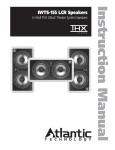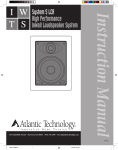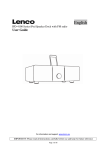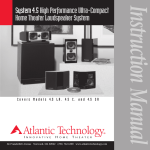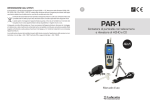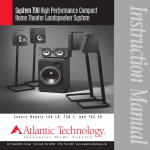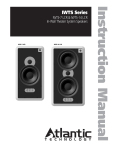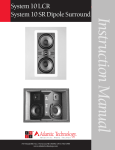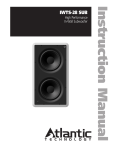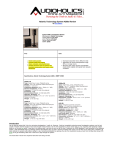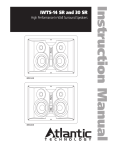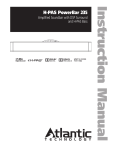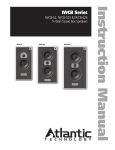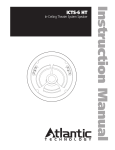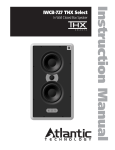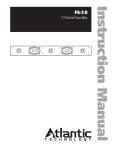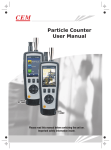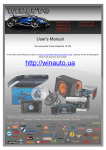Download IWTS Series - Volutone.com
Transcript
IWTS-5 LCR & IWTS-10 LCR In-Wall Theater System Speakers IWTS-5 LCR IWTS-10 LCR Instruction Manual IWTS Series 2 Safety Precautions IWTS-5 LCR & IWTS-10 LCR In-Wall Theater System Speakers Table of Contents 2 Model IWTS-5 LCR & IWTS-10 LCR 3 Important Considerations Before Installation 3 3 3 Recommended Wire Sizes Location Considerations Room Acoustics 3 4 Stereo Music Listening Home Theater Systems 5 5 IWTS-10 LCR In-Wall Enclosure Recommendations Ceiling Mounting Removing and Installing the Grille Cutting the Opening Installing the Mounting Frame Painting the Speaker Assembly Speaker Connection and Assembly Installing the Speaker Baffle Into the Frame IWTS-5 LCR & IWTS-10 LCR High Performance In-Wall Theater System Speakers 3 Speaker Placement 5 Mounting the IWTS Speakers 6 Installation of the IWTS in New Construction 6 Installation of the IWTS in Existing Construction 6 6 6 6 7 7 7 Front Panel Controls 7 7 HF (High Frequency) Level Control IR Knockout 7Specifications For Future Reference Record your serial numbers and date of purchase here: Model Number Serial Number Date of Purchase The serial number is found on the back panel. Copyright © 2012 Atlantic Technology International. Specifications are those in effect at the time of printing. Atlantic Technology reserves the right to change specifications or designs at any time without notice. Thank you for purchasing Atlantic Technology products. Our speaker systems have been designed to deliver exceptional sound and value. We hope you like what you hear from them, and are happy with your decision to buy them. Please take a few moments to read these instructions. They’re intended not only to tell you how to mount the speakers, but how to get the best performance from them. Speaker Placement Instruction Manual Important Considerations Before Installation Recommended Wire Sizes The longer the wire run, the heavier the wire should be. Use the following recommendations as a guide for your installation. And if you’re in doubt, remember that it never hurts to get the next heavier grade of wire. Also note that lower gauge numbers equal heavier wire sizes. Wire Run Wire Gauge: <15 ft. 16 ga. 15 to 30 ft. 14 ga. >30 to 50 ft. 12 ga. Location Considerations A major determinant of any speaker’s sound quality is its location in the room. With in-wall speakers there are fewer placement options than with free-standing speakers, so giving some thought to location can really pay off. Our In-Wall Theater Systems have been designed to minimize the detrimental effects wall mounting can have on sound, so they sound better than conventional in-wall speakers. Room Acoustics Hard surfaces create lots of sound reflections in the room while soft surfaces tend to absorb sound. Note the speakers’ location in terms of proximity to glass and other highly sound reflective or absorptive surfaces. A simple set of curtains or an area rug can make a major difference in sound quality and intelligibility by reducing excessive reflections. The more similar the speaker’s surroundings, the more consistent the sound will be. So placing one speaker directly adjacent to a glass wall, with the other speaker by an open archway, will make for two dramatically different sounding speakers. Note that as bass frequencies reflect within the room, some locations may be bass heavy while other areas may be bass shy. With an external subwoofer, changing its placement within the room may reduce these effects. But when in-wall speakers are utilized full range, the only real option is to change the listening position, if you end up in a difficult bass area. 3 Speaker Placement For all the following situations, it’s recommended that you first place small box speakers in the proposed locations, just to get a good idea of how that location will sound. In-wall speakers are tough to move once they’re installed! Stereo Music Listening For stereo music reproduction the speakers are best located at approximately ear level when seated, both on the same wall, facing the prime listening location. A separation of approximately six to eight feet between the left and right speakers is usually good. Ideally, the distance between the two speakers will be the same as the distance from the speakers to the listening position. The speakers and the listening position will then form an equilateral triangle. There is a benefit to mounting the speakers approximately the same distance from the side walls, so they both create the same reflective patterns. 4 Home Theater Placement IWTS-5 LCR & IWTS-10 LCR In-Wall Theater System Speakers Home Theater Systems Front Speaker Array should be placed as close to ear level as possible. Left Center Optional Dipole/Bipole Speakers should be placed directly to the sides of the seating area and approximately 1-2 feet (.3-.6 meter) above the listener’s ear level. Left Dipole Surround or Left IWTS-5 Surround Right Subwoofer Right Dipole Surround or Right IWTS-5 Surround Subwoofer placement is dependent on room size and shape. Experiment to find a location that produces the smoothest response. Today’s home theater systems require you to place six or more speakers in your room. For the most convincing theater effects, speaker placement must be very carefully thought out. This is especially true with in-wall speakers, since their installation is permanent! Left/Center/Right Locations The tweeter in the front three speakers should be at or just above ear height when seated, just as with stereo speakers. Try to keep the vertical position of the three front speakers within 18 inches of each other, as this will maintain smooth, believable left-center-right pans. Optional Direct Radiator Speakers should be placed slightly behind the listening position, above ear level. Left IWTS-5 Surround Back Right IWTS-5 Surround Back Optional Surround Back Speakers should be placed approximately 1-2 feet (.3-.6 meter) above the listener’s ear level. Bipole or direct radiators may be used here. The spacing of the left-right speakers can be a little wider than with 2-channel stereo speakers, since in a theater system, the center channel speaker reproduces the on-screen effects and anchors the center image. Left-right spacing of about 8 to10 feet usually works well. Surround Speakers In order to achieve optimum performance we strongly recommend Atlantic Technology Dipole or TriVector™ surround speakers. If you are using our dedicated surround speakers please follow the placement recommendations included in their installation instructions. Non-Dipole Surrounds The most realistic surround effects occur when the listener can’t localize the actual location of the surround speaker. If you decide to use the In-Wall Theater System speakers as surround speakers, mount them above the listeners’ ears, slightly behind the listening area either on the side or rear walls. Mounting the IWTS Speakers NOTE: We always recommend a professional be involved in the installation of IWTS speakers. The IWTS speaker can be easily mounted in most any standard wall material, from ½ to 1½ inches thick. Its rotating wall clamps (sometimes called "dog legs") firmly fix it to the wall surface after the proper cutout has been made. Here are some important precautions to take before mounting: 5 Mounting Instruction Manual As always, take care to wire the speakers properly, with the positive lead (normally marked with a red terminal or a “+” sign) from the amplifier connected to the positive terminal on the speakers and the negative (marked with a black terminal or a “-” sign) connected to its respective terminals. Proportions illustrated are for 16" on-center 2" X 4" stud installation. See table below for proper dimensions. Keep the sides of the actual mounting hole at least ½ inch away from beams or studs to ensure that the clamps have adequate room to rotate. A stud or other obstruction that’s too close will stop them from properly doing their job. Toe nail or screw to hold crossblock in position until sealant dries. Seal edges with caulking Wall cavity size will affect the bass and midrange performance of any in-wall speaker. The IWTS-5 LCR is designed to play optimally in a 0.5 to 1.0 cubic foot space (measured before wall insulation is inserted) and the IWTS-10 LCR in a 0.75 to 1.5 cubic foot space. Cubic dimensions can be determined by multiplying the length x width x height of the cavity. A larger cavity won’t hurt, but a smaller one will negatively impact the bass and midrange response of the system. Mounting Hole Outline Speaker Frame Outline Some of the sound from the speaker will transmit to the space on the other side of the wall cavity. If this is a major concern, you can build a box within the wall that provides the required cubic volume. Please note that there is very little room behind the drivers in a standard “2 x 4” wall cavity (there’s only 1/4 inch), so the back of any enclosure box must be made from thin material. Typically then, the back wall material of your enclosure will be roughly 1/8 to 1/4 inch thick. For optimum sound install we recommend lining the cavity with fiberglass or polyfill, observing all the relevant precautions and instructions from the insulation manufacturer. If you have built a back box, you can use common fiberglass insulation or open cell foam rubber in the enclosure. Be sure to push the insulation back from the drivers to ensure that it doesn’t get into the moving cone area. IWTS-10 LCR In-Wall Enclosure Recommendations Please use this information to construct an in-wall enclosure if you so desire. Doing so will generally improve the performance and increase the power handling of the system. Be sure to line the cavity with insulation, being careful to avoid letting the insulation touch the backs of the woofer cones. It’s also important to seal the joints of the enclosure with a high quality non-shrinking caulk. Be careful to keep the wires from touching the chassis of the drivers or baffle in such a manner that the wire might vibrate and buzz. You may use nylon wire ties to keep the wires properly positioned. Such ties are available that are designed to screw directly to studs making them ideal for this purpose. See table for proper dimension 2 x 4 Construction 1ft31.25ft3 2 x 6 Construction 1ft31.25ft3 16" O.C.Studs 34" 42.5" 16" O.C.Studs 21.7" 27" 24" O.C. Studs 22" 27.5" 24" O.C. Studs 16"* 17.5" *Minimum cut out height is 15.8". Placing the crossblock at 16" yields an internal volume of 1.15ft3. Ceiling Mounting It is especially important when mounting the speaker in a ceiling that you cover the back of the system with a fiberglass window screening (available at any home center or hardware store) to keep insulation and other foreign matter out of the assembly.You also should install safety wires from the rear of the assembly to a secure mounting place, like adjacent beams or the floor above, for added security. Should you be installing IWTS speakers in a suspended ceiling, it is imperative to install safety wires from the speaker to the support structure above, to ensure security under all conditions. 6 Installation IWTS-5 LCR & IWTS-10 LCR In-Wall Theater System Speakers Installation of the IWTS in New Construction Installing the Mounting Frame To re-install the grille later, press it carefully into the appropriate opening in the frame assembly. Since it’s designed to fit snugly, please take your time and use care when installing the grille. The clamping mechanism allows the wall material to range from ½ to 1½ inches (13 to 38 mm) in thickness. There must be a minimum depth behind the wall face of 3 5⁄8” (92 mm). As noted above, be sure to keep the edges of the cutout at least ½ inch (13 mm) away from any stud or obstruction, as the rotating clamps will not operate properly if you don’t. Insert the frame into the cutout and using a level or square carefully align it so it is level. Tighten the mounting screws, which will cause the attached clamps to rotate and position themselves properly behind the wall. For shipping, the speaker's baffle will be attached to the frame with two screws. Remove these screws to separate the baffle from the frame. Reserve the two screws for installation later. Continue to tighten until the frame is snug in the wall. You want the bezel to conform to the wallboard, and the frame not to rattle from the speaker’s vibration, but be very careful not to overtighten the screws. Cutting the Opening Painting the Speaker Assembly Atlantic Technology offers optional Rough-in Frame Kits (IN-NC-5 and IN-NC-10) to ease installation in new construction. Instructions for its use are included with that kit. Installation of the IWTS in Existing Construction Removing and Installing the Grille Remove the grille from the speaker using an awl or the point of a drywall screw in a grille opening near one of the grille corners. Slowly pry the grille out, being careful not to damage the speaker’s frame or its finish. The white plastic frame and the metal grille may be left as is, or painted to match your décor. You can paint the frame before or after it is installed in the wall. Spray painting (using slightly thinned paint) is the best method to use for painting the grille. Remove scrim before painting. After painting the grille, use air pressure to “blow out” any grille holes that are filled in with paint. Replace scrim after paint is dry. After determining the best location for the speaker as outlined above, use the enclosed template to cut the proper size hole. IWTS-5 LCR IWTS-10 LCR 7 1⁄8” x 9 ¾” (181 x 248mm) 7” x 15 13⁄16” (178 x 402mm) WARNING: Exercise extreme care before making any wall cuts to ensure that you will not cut through any wires, pipes, or other items that may be in the wall. You may sometimes, but not always, be able to determine the approximate location of wires and pipes by looking at the locations of nearby outlets and plumbing. But their location or absence is never an assurance that there is not something within the wall cavity. Front Panel Controls Instruction Manual Speaker Connection and Assembly 7 Specifications IWTS-5 LCR IWTS-10 LCR Type 2-wayM-T-M Optimum wall volume Drivers/Design 0.5 - 1 cu. ft. 0.5 - 1.25 cu. ft. woofers 1 - 6 ½" GLH* tweeter 1 - 1" Silk dome Frequency Response 52 - 20kHz ± 3dB 2 - 6 ½” GLH* 1 - 1” Silk dome 46 - 20kHz +/- 3dB Sensitivity87dB 89dB Impedance 6 Ohms 6 Ohms Crossover Frequency Amplifier Power 3400Hz, 4th order Linkwitz-Riley 25-125 Watts 25-150 Watts Dimensions (grill frame) 8 / " x 11" x 3 / "8 7/16" x 17¼” x 3 5/8" (W x H x D) 215 x 280 x 86mm 215 x 438 x 86mm 7 16 Strip about ½” (13 mm) of insulation from the connecting wires. Connect them to the appropriate push terminal, being careful to observe polarity (positive to the red terminal, negative to the black terminal). 58 Cutout Dimensions7 1/8" x 9¾" (W x H) 181 x 248mm 7” x 15 13/16" 178 x 402mm Net Weight 7.5lbs; 3.4kg each 6.3lbs; 2.8kg each New Construction KitIN-NC-5 IN-NC-10 *Graphite Loaded Homopolymer Installing the Speaker Baffle into the Frame Specifications are those in effect at the time of printing. Atlantic Technology reserves the right to change specifications or appearance at any time without notice. Once the frame is mounted in the wall, the speaker simply fits into the frame. Use the included screws (including two removed earlier) to attach the baffle to the mounting frame, but be very careful not to overtighten the screws. Should you have any questions or problems please feel free to contact us at 781-762-6300 or through our web site, www.atlantictechnology.com. Front Panel Controls HF (High Frequency) Level Control This control adjusts the relative level of high frequency output to compensate for varying room acoustics or placement behind a screen. “+2” is for absorptive, acoustically “dead” rooms (or when the speaker is behind a movie screen). Use this position to increase the HF level and restore the proper sparkle and liveliness to the sound. “0” is for rooms of average absorptive characteristics. “-2“ should be used in rooms that are highly reflective, with hard floors and exposed windows. The setting of the HF control is mostly a matter of personal taste, so try it in all three positions and see which one is preferred. for non-localizable surround use, or for room-filling background music (“whole house audio”) use. IR Knockout There’s a “knockout” plug in the front baffle. You can identify it by locating the Atlantic Technology wave logo which is molded into it. If you are using a multi-room control system, you can install a standard IR receiver in the knockout hole. 343 Vanderbilt Avenue Norwood, MA 02062 (781) 762-6300 www.atlantictechnology.com 015-1160








